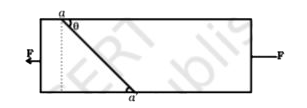मान लीजिये और पर स्थित दो द्रव्यमानो तथा के बीच गुरुत्वाकर्षण बलों तथा के लिए न्यूटन के गुरुत्वाकर्षण नियम को द्वारा व्यक्त किया जाता है। यहाँ एक स्थिरांक है जिसकी विमा द्रव्यमान की है। तथा n कोई संख्या है। ऐसे प्रकरण में
पृथ्वी पर गुरुत्वीय त्वरण विभिन्न पिंडो के लिए भिन्न-भिन्न होगा।
केप्लर के तीनो नियमो में से कोई भी वैध नहीं होगा।
केवल तीसरा नियम ही अवैध हो जाएगा।
n के ऋणात्मक होने पर जल से हल्के पिंड जल में डूब जाएँगे।
Step by step video & image solution for मान लीजिये r_(1) और r_(2) पर स्थित दो द्रव्यमानो m_(1) तथा m_(2) के बीच गुरुत्वाकर्षण बलों F_(1) तथा F_(2) के लिए न्यूटन के गुरुत्वाकर्षण नियम को F_(1)= -F_(2)= - (r_(12))/(r_(12)^(3)) GM_(0)^(2) ((m_(1)m_(2))/(M_(0)^(2)))^(n) द्वारा व्यक्त किया जाता है। यहाँ M_(0) एक स्थिरांक है जिसकी विमा द्रव्यमान की है। r_(12)= r_(1)-r_(2) तथा n कोई संख्या है। ऐसे प्रकरण में by Physics experts to help you in doubts & scoring excellent marks in Class 11 exams.
Updated on:21/07/2023Topper's Solved these Questions
- गुरुत्वाकर्षणBOOK - NCERT EXEMPLAR HINDICHAPTER - गुरुत्वाकर्षणEXERCISE - अति लघु उत्तरीय प्रश्न
11 Videos
- गुरुत्वाकर्षणBOOK - NCERT EXEMPLAR HINDICHAPTER - गुरुत्वाकर्षणEXERCISE - लघु उत्तरीय प्रश्न
6 Videos
- गति के नियम BOOK - NCERT EXEMPLAR HINDICHAPTER - गति के नियम EXERCISE - दीर्घ उत्तरीय प्रश्न
9 Videos
- ठोसों के यांत्रिक गुणBOOK - NCERT EXEMPLAR HINDICHAPTER - ठोसों के यांत्रिक गुणEXERCISE - दीर्घ उत्तरीय प्रश्न (LA)
5 Videos
Similar Questions
वायुमंडल में वायु के अणु पृथ्वी के गुरुत्व बल द्वारा आकर्षित किये जाते है। स्पष्ट कीजिये, ये सभी वृक्ष से सेब की भांति पृथ्वी पर क्यों नहीं गिरते ?
View Solutionमाध्य सौर दिन उन दो कर्मगत दोपहरों के बीच का काल-अंतराल है जब सूर्य शिरो बिंदु (ध्रुव वृत्त) से गुजरता है।
नक्षत्र दिन किसी दूरस्थ सौर के माध्य बिंदु (शिरो बिंदु) (ध्रुव वृत्त) से दो क्रमागत संक्रमणो के बीच काल-अंतराल है।
उपयुक्त आरेख खींचकर, जो पृथ्वी का चक्रण तथा कक्षीय गति दर्शाता हो, यह दर्शाइए कि माध्य सौर दिन से 4 मिनट अधिक अवधि का होता है। दूसरे शब्दों में, दूरस्थ तारा प्रत्येक क्रमागत दिनों में 4 मिनट पहले उदय होगा।
(संकेत: आप पृथ्वी की कक्षा वृत्ताकार मान सकते है )।
View Solutionकिसी पिंड के बिंदु F1,F2 एवं F3 तीन बल लगे हैं। इन बलों के प्रभाव में पिंड एक समान चाल से गति करता है ?
(a) दर्शाइए कि बल समतलीय है।
(b) दर्शाइए कि पिंड के किसी बिंदु के परितः इन तीन बलों के कारण कुल बल-आघूर्ण शून्य होगा।
View Solutionस्टील की लंबी छड़ पर विचार कीजिए जिसके सिरों पर लंबाई के अनुदिश लगे बल Fके कारण तनन प्रतिबल है (चित्र 9.5)। एक ऐसे तल पर विचार कीजिए जो लंबाई से θ कोण बनाता है। इस तल पर तनन-प्रतिबल तथा अवरूपण-प्रतिबल क्या है?
(a) किस कोण के लिए तनन प्रतियल अधिकतम है?
(b) किस कोण के लिए अवरूपण प्रतिबल अधिकतम है?

View SolutionTwo planets of radii R_(1) and R_(2 have masses m_(1) and M_(2) such that (M_(1))/(M_(2))=(1)/(g) . The weight of an object on these planets is w_(1) and w_(2) such that (w_(1))/(w_(2))=(4)/(9) . The ratio R_(1)/R_(2)
View SolutionThe figure represents two concentric shells of radii R_(1) and R_(2) and masses M_(1) and M_(2) respectively. The gravitational field intensity at the point A at distance a (R_(1) lt a lt R_(2)) is
View SolutionSupposing Newton's law of gravitation for gravitation force F1 and F2 between two masses m1 and m2 at positions r1 and r2 read F2=−F2=r12r312GM20(m1m2M20)n where M0 is a constant dimension of mass, r12=r1−r2 and n is number. In such a case.
View SolutionSupposing Newton's law of gravitation for gravitation force F1 and F2 between two masses m1 and m2 at positions r1 and r2 read F2=−F2=r12r312GM20(m1m2M20)n where M0 is a constant dimension of mass, r12=r1−r2 and n is number. In such a case.
View SolutionTwo concentric spherical shells have masses m_(1) and m_(2) and radii r_(1) and r_(2) (r_(2) gt r_(1)) . What is the force exerted by this system on a particle of mass m_(3) . If it is placed at a distance r(r_(1) lt r lt r_(2)) from the centre ?
View SolutionSupposing Newton's law of gravitation for gravitation forces F_(1) and F_(2) between two masses m_(1) and m_(2) at positions r_(1) and r_(2) read where M_(0) is a constant of dimension of mass, r_(12) = r_(1) - r_(2) and n is a number. In such a case,
View SolutionAssertion : Two satellites of mass m_(1)& m_(2)(m_(1) gt m_(2)) are going around the earth in orbit of raddi s r_(1) and r_(2)(r_(1) gt r_(2)) . Reason : They will have same velocity .
View Solutionद्रव्यमान केंद्र क्या है ? द्विकण निकाय के लिए सिद्ध कीजिए कि −−→rcm=m1→r1+m2→r2m1+m2
जहाँ संकेतों के सामान्य अर्थ हैं ।
View Solutionm1 तथा m2 द्रव्यमान (m1>m2) के दो उपग्रह पृथ्वी के चारों ओर क्रमशः r2 तथा r2(r1>r2) त्रिज्याओं की वृत्तीय कक्षाओं में घूम रहे हैं । उनकी चाल v1 तथा v2 के विषय में कौन - सा कथन सत्य है -
View Solutionयदि दो द्रव्यमान m1 तथा m2 की द्रव्यमान kendr से दूरी क्रमश : r1 तथा r2 हो तो r1r2 का मान होगा -
View SolutionTwo satellites of masses m_(1) and m_(2)(m_(1) gt m_(2)) are revolving around the earth in circular orbits of radius r_(1) and r_(2)(r_(1) gt r_(2)) respectively, which of the following is true regarding their speeds V_(1) and V_(2) ?
View SolutionTwo satellites of masses m1andm2(m1>m2) are moving around the earth in orbits of radii r1andr2(r1>r2). Which one of the following statements about their velocities is correct?
View Solution
